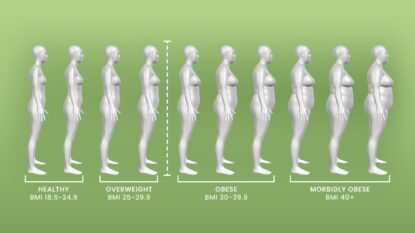What Does Obesity Look Like? Understanding BMI & Its Impact on Health
Obesity can be difficult to spot. It doesn’t have a single “look” and regardless, as the nation grows larger year on year, those who are carrying too much weight and who would have stood out in years gone by, simply blend in, making it harder to visually identify.
Even when some people do appear outwardly heavier, depending on how their weight is distributed or unless they’re carrying a large amount of excess fat, it can be hard to tell if it’s ‘too much’ and this is
In this article, we’ll explain what obesity is, what BMI and it’s specific categories are and any exceptions to this and how to measure it. Additionally, we’ll explain what this means within the context of obesity-related treatment and weight management, and how LighterLife’s programmes can help you effectively address your weight and live a healthier, more confident life.
What is Obesity?
Obesity is defined as an abnormal or excessive fat accumulation which can impair health. It’s usually defined using the Body Mass Index (BMI) measurement which describes how much weight you are carrying relative your height. Obesity is characterized by a greater amount of fat than is considered healthy which can lead to numerous and varied health problems. Whilst obesity is not a simple issue of excess weight, but instead a complex condition with multiple contributing factors, it is a chronic disease rooted in the function, amount, and distribution of fat (adipose) tissue.
According to the WHO, obesity is linked to increased risk of delevoping several serious health conditions, including type 2 diabetes, heart disease, certain types of cancer, and various mental health issues including anxiety and depression.
So, it’s not just about size — being obese for a prolonged period of time, is a genuine risk to long-term health.
Understanding BMI: What Do the Numbers Mean?
Originally devised by a mathematician in the 19th century, BMI was intended to provide a quick and straightforward way to indicate the degree of obesity of the general population in order to assist the government in allocating resources. Also called the Quetlet index, this value determines the weight to height distribution and is very simple to calculate.
BMI is a simple calculation: your weight (in kilograms) divided by your height (in metres) squared.
So, for example, for a woman who is 5ft 5in and weighing 13st needs to first convert her weight to kilos and her height to metres. Then the BMI calculation would be:
- 82.5 / (1.65 x 1.65) = 30
Find out your BMI here.
BMI Categories:
For most adults, if your BMI is:
- below 18.5 – you’re in the underweight range
- 18.5 to 24.9 – you’re in the healthy weight range
- 25 to 29.9 – you’re in the overweight range
- 30 to 39.9 – you’re in the obese range
- 40 or above – you’re in the severely obese range
A different, slightly lower set of BMI ranges is used as a reference to indicate overweight and obesity if you come from an Asian, Chinese, Middle Eastern, Black African, or African-Caribbean family background:
- 23 to 27.4 – you’re in the overweight range
- 27.5 or above – you’re in the obese range
BMI isn’t perfect — it doesn’t account for muscle mass or distribution of fat — so a very large rugby player whose BMI would likely be well above 30 due to large amounts of muscle, would not be medically obese. But it is a fair starting point, especially when used alongside waist measurements and health assessments.
BMI and Weight Loss
If your BMI puts you in the overweight or obese category, you may initially be a little shocked. Many are because they didn’t realise that their weight is potentially starting to become problematic. So, what should you do next?
Well, the good news is that you can start to work towards lowering your BMI with a structured, scientifically proven weight loss plan. At LighterLife, we’ve helped hundreds of thousands of people reduce their BMI, and in many instances help improve various health conditions including reversing type 2 diabetes, reducing their blood pressure, reduce symptoms of osteoarthritis and more. And on top of all of this, we have seen thousands upon thousands of people improve their mental wellbeing and reclaim their confidence.
You don’t have to do it alone. With the right tools and support, you can take control of your health — one decision at a time.
Effective Ways to Reduce BMI for Better Health
There are many ways to help reduce your BMI, and our weight-loss methods here at LighterLife are safe and sustainable. We offer as part of our Re-Create me programme:
- Very Low-Calorie Diets (VLCDs) backed by medical research
- Cognitive Behavioural Therapy (CBT) for long-term mindset change
- One-to-one support from trained mentors
- Easy-to-follow meal replacements with all essential nutrients
- Online tools and community to stay motivated
Why Choose LighterLife for Weight Loss?
LighterLife isn’t just another diet — it’s a transformational programme designed to help you lose weight and keep it off.
Thousands of people have used LighterLife to reduce their BMI, come off medication, and feel more in control of their lives. Our approach combines medical science, nutrition, and psychology to help you break free from food noise and unhealthy habits.
“I lost 4 stone with LighterLife, and my BMI dropped from 35 to 25. I feel like myself again.” – Sarah, age 48
Obesity FAQ
Q: What BMI is considered obese?
A: A BMI of 30 or above is classified as obese. A BMI of 25 or over is considered overweight.
Q: What causes obesity?
A: It is not a simple issue of excess weight, but rather a complex condition with multiple contributing factors including overeating, lack of physical activity, emotional eating, hormonal conditions, genetics and more.
Q: Can I reduce my BMI with diet alone?
A: Yes, reducing calorie intake is the most effective way to lower BMI. LighterLife offers structured plans that make this easier and safer.
Q: Is obesity reversible?
A: Absolutely. Many people reduce their BMI and improve their health through a combination of diet, support, and behaviour change.





